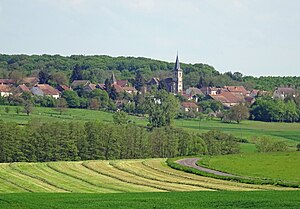Châtenois (Haute-Saône)
| Châtenois | ||
|---|---|---|
|
|
||
| region | Bourgogne-Franche-Comté | |
| Department | Haute-Saône | |
| Arrondissement | Lure | |
| Canton | Lure-1 | |
| Community association | Triangle Vert | |
| Coordinates | 47 ° 41 ′ N , 6 ° 19 ′ E | |
| height | 278-413 m | |
| surface | 5.75 km 2 | |
| Residents | 118 (January 1, 2017) | |
| Population density | 21 inhabitants / km 2 | |
| Post Code | 70240 | |
| INSEE code | 70141 | |
 View of Châtenois |
||
Châtenois is a municipality in the French department of Haute-Saône in the region Bourgogne Franche-Comté .
geography
Châtenois is located at an altitude of 321 m above sea level, three kilometers east-southeast of Saulx and about 14 kilometers northeast of the city of Vesoul (as the crow flies). The village extends in the central part of the department, east of the Saulx basin, on a slightly elevated position east of the lowland of the Ruisseau de Châteney , at the foot of the heights of the Bois de Vaugirard .
The area of the municipal area of 5.75 km² covers a section in the undulating landscape between the basin of Saulx in the west and the plain of Lure in the east. From north to south the area is crossed by the alluvial valley of the Ruisseau de Châteney . It provides drainage to the Colombine , which marks the southern boundary. The valley lowlands lie at an average of 280 m and have a maximum width of one kilometer. Agricultural use prevails here.
To the east, the community area extends over the slope of Châtenois to the adjacent ridge, which is elongated in a north-south direction. It is covered by the forest of the Bois de Vaugirard . At 413 m, the highest point of Châtenois is reached on this plateau. From a geological and tectonic point of view, the area is divided up by several fault lines running in a north-south direction. The terrain consists of alternating layers of sandy-marl and calcareous sediments that were deposited during the Lias ( Lower Jurassic ). In some places, shell limestone from the Middle Triassic also emerges.
Neighboring municipalities of Châtenois are Châteney in the north, Adelans-et-le-Val-de-Bithaine and La Creuse in the east, Velleminfroy and Colombotte in the south and Creveney and Saulx in the west.
history
The area around Châtenois was already inhabited in prehistoric times. The earliest evidence of human presence comes from the Neolithic . There are also traces of a settlement from Gallo-Roman times. Châtenois is mentioned in a document in the 13th century. The place name is derived from the French word châtaigne (chestnut tree). In the Middle Ages, the village belonged to the Free County of Burgundy and in that part of the Bailliage d'Amont . For a long time Châtenois and Châteney formed a fiefdom that belonged to the Lords of Faucogney. The castle was in Châtenois. Only in the 16th century, after the castle was destroyed, the two villages were separated. Together with the Franche-Comté , Châtenois finally came to France with the Peace of Nijmegen in 1678. Today Châtenois is a member of the community association Communauté de communes du Pays de Saulx, which comprises 17 villages .
Attractions
The village church of Châtenois was rebuilt in the 19th century. Its furnishings include a richly carved pulpit, coat of arms of the von Châtenois family and a large painting of the Resurrection of Christ (18th century). Only sparse remains of the former castle, including a portal (18th century), have been preserved. In the center there is a red sandstone lavoir, which was built in 1890 and restored in 1998. It was once used as a wash house and cattle trough.
population
| Population development | |
|---|---|
| year | Residents |
| 1962 | 91 |
| 1968 | 104 |
| 1975 | 97 |
| 1982 | 112 |
| 1990 | 108 |
| 1999 | 126 |
| 2006 | 130 |
With 118 inhabitants (January 1, 2017) Châtenois is one of the small communities in the Haute-Saône department. After the population had decreased significantly in the first half of the 20th century (273 people were counted in 1881), slight population growth has been recorded again since the mid-1970s.
Economy and Infrastructure
Châtenois is still a village dominated by agriculture (arable farming, fruit growing and cattle breeding) and forestry. Outside of the primary sector there are few jobs in town. Some workers are therefore commuters who work in the larger towns in the area and in the Vesoul agglomeration.
The village is located off the major thoroughfares on a department road that leads from Velleminfroy to Genevrey . Another road connection is with Saulx. The railway line from Belfort to Vesoul runs through the municipality . The nearest train station is in Creveney.
